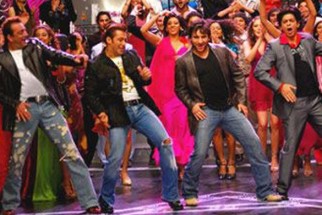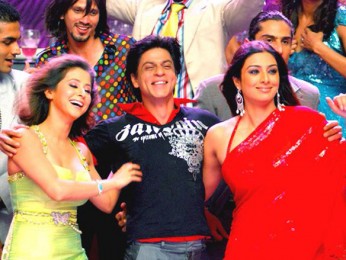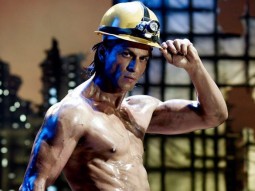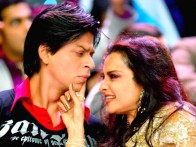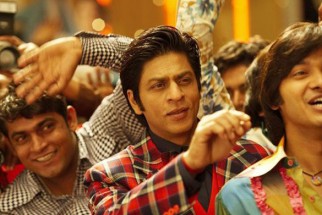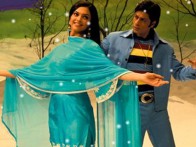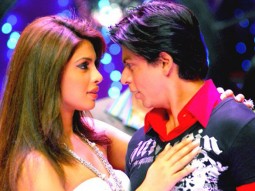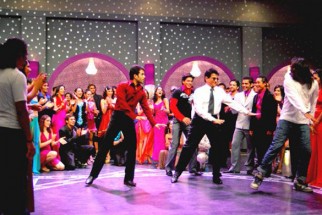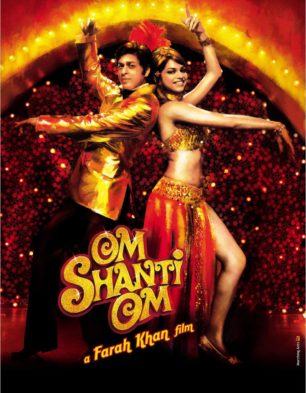Growing up in the seventies in India automatically implied a steady diet of Hindi masala films. They were three-hour deliciously lowbrow extravaganzas packed with songs and dances, melodrama, overwrought plot lines that were pinched from any number of sources, and staggeringly huge lapses of continuity and logic. Such was their peculiar goofy charm that we overlooked any affront (intended or otherwise) to intelligence. This “formula†had several practitioners, the foremost being Manmohan Desai, whose “Amar, Akbar, Anthony†had scenes of inspired looniness that remain unrivaled to this day. Of course, they were silly, but they were magnificent fun, and are all the more beloved because they date back to our childhood. It seemed the world was young and carefree, so full of promise, optimism, and potential that even the most implausible Hindi film somehow seemed credible.
Thirty years later, director Farah Khan has made “Om Shanti Omâ€, an ode to that era of Indian cinema. With great affection, the film references the blockbusters, the garish fashions (that we faithfully mimicked and thought so groovy), the stars, and the melodramatic story lines of that time. Magpie-like, Farah has filched bright and shiny objects of improbable provenance to embellish her homage to the films of her (and our) childhood. I read somewhere that she conjured up the idea for “Om Shanti Om†while she was a houseguest of Andrew Lloyd-Webber. Sir Andrew, himself a practitioner of the deliciously lowbrow, might be flattered that in her film, Farah has staged a number reminiscent of his own “Masquerade†from his long-running, yet soulless “The Phantom of the Operaâ€. Like him, she has assigned a rather important role to a lighting fixture, and used a symphonic orchestra as back-up band (the Prague Philharmonic—certainly a first in Hindi cinema) for her hero’s show-stopping finalé.
Along with these new elements, she includes nods to actors, famous films of the seventies and eighties, and thanks to the magic of CGI, even a brilliant number where her leading lady sings and dances with major stars of yesteryear.
“Om Shanti Om†opens with the shooting of the 1980 Subhash Ghai hit “Karzâ€. (Avid cinéphiles know "Karz" was “inspired†by the American film “The Reincarnation of Peter Proudâ€.) In fact, the song “Om Shanti Om†is being filmed on Rishi Kapoor, the hero of “Karzâ€, and Om Prakash Makhija, the background performer (junior artiste, in Hindi film parlance) hero of “Om Shanti Omâ€, is one of the faceless members of the studio audience. Om Prakash Makhija loves the movies and cannot believe his good fortune that he is allowed to exist at the fringes of the film industry. He is filled with wonderment at every aspect of cinema. When asked what he loves about film, he joyfully exclaims, Everything! I love the studio, the sets, the costumes and make-up, lights, camera, action, and signing autographs. Om Prakash gives voice to every cinephile, every closet actor, and every frustrated performer. One can sagely laugh at his naïvete, but there is something heroic and gallant about Om Prakash Makhija. Om Prakash’s most sincere dream is to be a big star someday, and like an Indian Walter Mitty (with some clever CGI help), he imagines himself in Rishi Kapoor’s place, in a silver lamé glam-rock jumpsuit, basking in the applause and adulation of screaming fans. Om Prakash Makhija has another, just as unattainable dream: Shantipriya, the most successful and glamorous leading lady of the era. He addresses large chunks of romantic dialogue to her gigantic beautiful visage that looms over him from a street-side hoarding for her latest film, “Dreamy Girlâ€, oblivious to the snickers of passers-by. Along with his dreams, Om Prakash has a mother who believes he can accomplish anything, and a selfless best friend who wants nothing more than for Om to succeed. The filmi Ma and the best buddy are ubiquitous tropes of Indian cinema, and in the hands of Kirron Kher and Shreyas Talpade, the roles are both deftly spoofed and played straight for poignant dramatic effect.
As this is the movies, anything can happen, and frequently does. Within moments, Om Prakash finds himself having a close encounter with Shantipriya at the premiere of “Dreamy Girlâ€. Then the next day, he is a background-perfomer in a scene where the hero saves Shantipriya from a blaze. The leading man loses his nerve when the fire goes out of control, and our man Om Prakash Makhija jumps in to save the day. Om and Shanti become friends. However before he can profess his love to her, things go horribly wrong, and Om Prakash perishes trying to save her life.
Thirty years later, we meet a reigning superstar of Hindi cinema, Om Kapoor, with a distinct resemblance to the deceased O. P. Makhija. He is spoilt, obnoxious, and oversexed, everything poor hapless short-lived background-performer Om Prakash was not. But once his memory is given a few jolts by some staged studio fires and a random visit to a derelict film studio, he realizes he is Om Prakash Makhija, reborn to avenge past wrongs. There is a beautiful twist to the tale at the end and justice is served.
I loved everything about “Om Shanti Omâ€. In Farah Khan’s previous film, the hit “Main Hoon Naâ€, she had passing references to the songs and the look of the seventies. Her new opus, “Om Shanti Om†is an unabashedly shrewd and commercial film, but there is no denying that it is a full-blown love letter to the cinema of the seventies. For years, I was ambivalent about Shah Rukh Khan’s work: I thought him smug and full of himself in his early films, then loved his smart aleck character in “Kabhi Haan Kabhi Naaâ€, the Ketan Mehta gem, loved Kajol and him in “Dilwale Dulhaniya Le Jayengeâ€, hated his self-regarding “Asokaâ€, then thought his performance very strong in the overly-lavish “Devdasâ€, and so it went. But with “Main Hoon Naâ€, “Paheliâ€, “Chak De Indiaâ€, and even the Karan Johar NRI (Non-Resident Indian) sagas, I have become a big admirer. Success agrees with Shah Rukh Khan, the actor: he seems to try less hard to make an impression, is comfortable in his skin, and so can focus better on the character he is playing. His willingness to laugh at himself makes his screen persona that much more appealing. “Om Shanti Om†pokes gentle fun at the interchangeable Raj-Rahul characters he has portrayed in innumerable films: clips of Om Kapoor’s nominated films at an awards show feature him mouthing the same inane dialogue with different leading ladies in the same bucolic Swiss setting. In another scene, he sheepishly acknowledges criticism about his over-acting. Shah Rukh Khan is simply wonderful as the two Oms, creating two distinct characters with a single mission.
Special mention must be made of suave villain Arjun Rampal and Deepika Padukone, the new find who plays the ‘70’s star Shantipriya. With her statuesque beauty and patrician elegance, she recalls Hema Malini in her heyday. In even the cheesiest settings and the most ridiculous costumes and makeup, Ms. Malini—and now Ms. Padukone—would display an innate dignity. The villainous Mukesh Mehra is urbane, sophisticated and amoral, for he stops at nothing to succeed, and Arjun Rampal brings new dimensions and great panache to a conventional film character. Another star of the film is the production design. I loved the gorgeous Art Deco film studio, the film sets, the vibrant color scheme and look of the film. The music enhances the entertainment quotient of the film. A highlight was the “Deewangi†song celebrating Om Kapoor’s Filmfare Award win at a party attended by all the stars—past and present—of Hindi cinema. Great care and thought (money, too) have gone into this project, and modern film technology is used seamlessly to render the illusion all the more believable.
“Om Shanti Om†is a celebration of the fun and the joy of Indian cinema, a hugely satisfying Diwali gift to Indian filmgoers, and Farah Khan deservedly has an enormous hit on her hands.

